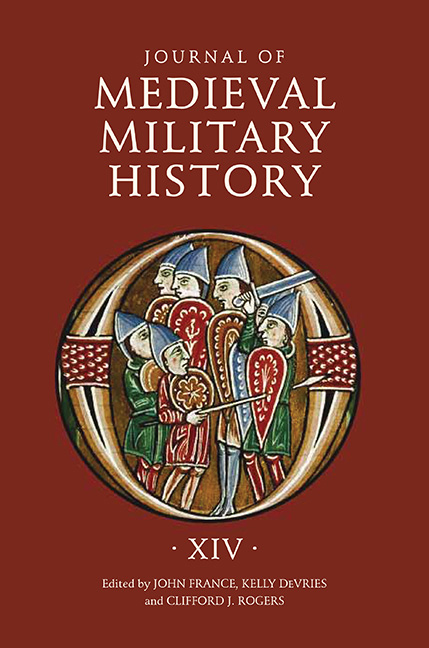Book contents
- Frontmatter
- Contents
- 1 Anglo-Norman Artillery in Narrative Histories, from the Reign of William I to the Minority of Henry III
- 2 Imperial Policy and Military Practice in the Plantagenet Dominions, c. 1337–c. 1453
- 3 The Parliament of the Crown of Aragon as Military Financier in the War of the Two Pedros
- 4 Chasing the Chimera in Spain: Edmund of Langley in Iberia, 1381/82
- 5 Note: A Medieval City under Threat Turns Its Coat, while Hedging Its Bets – Burgos Faces an Invasion in Spring 1366: Introduction and Translation
- 6 Medieval European Mercenaries in North Africa: The Value of Difference
- 7 Medieval Irregular Warfare, c. 1000–1300
- 8 Muslim Responses to Western Intervention: A Comparative Study of the Crusades and Post-2003 Iraq
- 9 “New Wars” and Medieval Warfare: Some Terminological Considerations
- 10 Friend or Foe? The Catalan Company as Proxy Actors in the Aegean and Asia Minor Vacuum
- List of Contributors
- Journal of Medieval Military History
- De Re Militari and the Journal of Medieval Military History
7 - Medieval Irregular Warfare, c. 1000–1300
Published online by Cambridge University Press: 12 September 2017
- Frontmatter
- Contents
- 1 Anglo-Norman Artillery in Narrative Histories, from the Reign of William I to the Minority of Henry III
- 2 Imperial Policy and Military Practice in the Plantagenet Dominions, c. 1337–c. 1453
- 3 The Parliament of the Crown of Aragon as Military Financier in the War of the Two Pedros
- 4 Chasing the Chimera in Spain: Edmund of Langley in Iberia, 1381/82
- 5 Note: A Medieval City under Threat Turns Its Coat, while Hedging Its Bets – Burgos Faces an Invasion in Spring 1366: Introduction and Translation
- 6 Medieval European Mercenaries in North Africa: The Value of Difference
- 7 Medieval Irregular Warfare, c. 1000–1300
- 8 Muslim Responses to Western Intervention: A Comparative Study of the Crusades and Post-2003 Iraq
- 9 “New Wars” and Medieval Warfare: Some Terminological Considerations
- 10 Friend or Foe? The Catalan Company as Proxy Actors in the Aegean and Asia Minor Vacuum
- List of Contributors
- Journal of Medieval Military History
- De Re Militari and the Journal of Medieval Military History
Summary
Insurgent actions are similar in character to all others fought by second-rate troops: they start out full of vigor and enthusiasm, but there is little level-headedness and tenacity in the long run.
Thus Clausewitz dismisses irregular soldiers, but he was writing in an age when the contrast between regular and irregular warfare was very sharp. On the one hand there were the state armies of uniformed men, often with bands, marching in set formations and committed to well-defined savage and close-range confrontations. On the other there were what we have learned to call guerrillas, who wore no uniforms and were often poorly armed, wholly indistinguishable from the rest of the population, and who operated hit and run by ambush. The line between these was slightly blurred because various powers deployed irregulars, such as so-called “Croats” and Hussars, and even by the existence of sharpshooters like the British Rifle Brigade, but these were essentially only ancillary to the regulars. This sharp distinction between official and “other” forces has imprinted itself on our consciousness and forms the whole basis of military law as applied to relations between armies and populations. Yet it was a phenomenon of a particular age. War has changed since, and it was certainly very different from this stereotype before, and especially in the Middle Ages.
For in medieval Western Europe there was no such thing as a regular standing army. Towards 1100 the English crown, with what was then its unusual tax-raising capacity, had established a royal military household, but it formed only the kernel around which real armies could be organized in their short-term existences. For even the English crown could not support large forces over long periods of time. At the end of the twelfth century, Richard I of England (1189–99) conceived of the idea of raising a permanent body of 300 knights, apparently to be paid for by remitting “feudal” service for taxes. Magnate resistance scuppered the idea, and Richard could not pay for it out of his own resources because it would have cost over half the normal annual income of the crown. In fact, in the eleventh century the English kings were unusual, because most monarchs were struggling to assert the ascendancy implied by their title. Essentially, kings were landowners amongst other landowners who all felt they could use armed force in pursuit of their ends.
- Type
- Chapter
- Information
- Journal of Medieval Military HistoryVolume XIV, pp. 123 - 132Publisher: Boydell & BrewerPrint publication year: 2016



